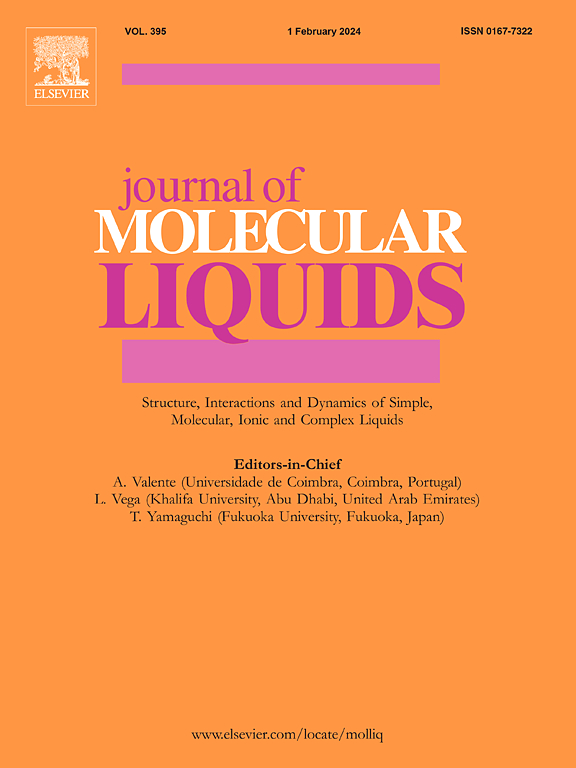Impact of antifreeze and promoter on clathrate hydrate nucleation and growth
IF 5.3
2区 化学
Q2 CHEMISTRY, PHYSICAL
引用次数: 0
Abstract
A deeper understanding of the nucleation and growth mechanisms involved in carbon dioxide (CO2)/methane (CH4) gas hydrate formation has significant implications for natural gas exploitation, as well as for greenhouse gas capture, storage, and transportation. To enhance CO2/CH4 gas uptake, introducing chemical additives into the solution can effectively accelerate the hydrate formation process. In this study, we employ molecular dynamics to examine how antifreeze molecules like ammonia (NH3) and methanol (CH3OH), along with and without the thermodynamic promoter tetrahydrofuran (THF), influence the kinetics of CO2/CH4 gas hydrate nucleation and growth stages. We find that nucleation does not occur in the presence of antifreeze at 100 % CO2 gas in solution, while it does occur with gas mixtures containing 75 % and 50 % CO2 within simulation time period. The results demonstrate that hydrate nucleation begins with the formation of the small 512 cages and a greater number of these small cages are formed compared to the large 62512 and 64512 cages. Furthermore, in the presence of THF or a combination of antifreeze and THF, cage formation increases as CO2 concentration in the gas mixtures reduces. The concentration of CO2 in gas mixture significant influences the cages formation when both an antifreeze and a promoter are present. The result display that in the presence of both antifreeze and promoter reduces the induction time and enhances the nucleation rate of the gas hydrate formation compared to the presence of an antifreeze alone. The finding supports experimental evidence that more CH4 molecules are trapped in the 512 cages when both antifreeze and THF are present, compared to hydrate formation without antifreeze. Furthermore, the study highlights the influence of temperature, pressure, and antifreeze molecule concentration on gas hydrate formation. The results indicate that increasing temperature reduces the hydrate formation during the initial formation stage but promotes the trapping of more gas molecules inside the cages during the growth phase Additionally, higher antifreeze concentrations suppress both gas hydrate formation and gas uptake capacity. At elevated temperatures (270 K and 50 MPa), the formation of a greater number of 512 and 64512 cages is observed, with THF molecules predominantly occupying the 64512 cages, suggesting the formation of THF hydrates. The finding reveals the effect of thermodynamic conditions and chemical additives in gas hydrate formation processes.

求助全文
约1分钟内获得全文
求助全文
来源期刊

Journal of Molecular Liquids
化学-物理:原子、分子和化学物理
CiteScore
10.30
自引率
16.70%
发文量
2597
审稿时长
78 days
期刊介绍:
The journal includes papers in the following areas:
– Simple organic liquids and mixtures
– Ionic liquids
– Surfactant solutions (including micelles and vesicles) and liquid interfaces
– Colloidal solutions and nanoparticles
– Thermotropic and lyotropic liquid crystals
– Ferrofluids
– Water, aqueous solutions and other hydrogen-bonded liquids
– Lubricants, polymer solutions and melts
– Molten metals and salts
– Phase transitions and critical phenomena in liquids and confined fluids
– Self assembly in complex liquids.– Biomolecules in solution
The emphasis is on the molecular (or microscopic) understanding of particular liquids or liquid systems, especially concerning structure, dynamics and intermolecular forces. The experimental techniques used may include:
– Conventional spectroscopy (mid-IR and far-IR, Raman, NMR, etc.)
– Non-linear optics and time resolved spectroscopy (psec, fsec, asec, ISRS, etc.)
– Light scattering (Rayleigh, Brillouin, PCS, etc.)
– Dielectric relaxation
– X-ray and neutron scattering and diffraction.
Experimental studies, computer simulations (MD or MC) and analytical theory will be considered for publication; papers just reporting experimental results that do not contribute to the understanding of the fundamentals of molecular and ionic liquids will not be accepted. Only papers of a non-routine nature and advancing the field will be considered for publication.
 求助内容:
求助内容: 应助结果提醒方式:
应助结果提醒方式:


